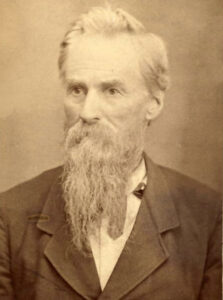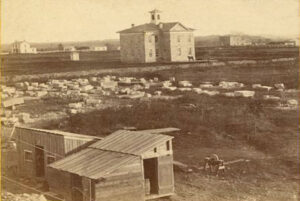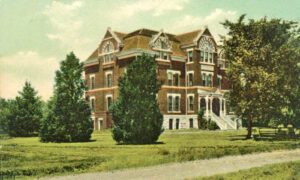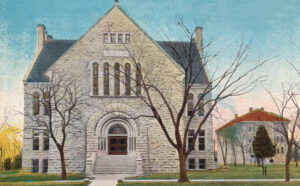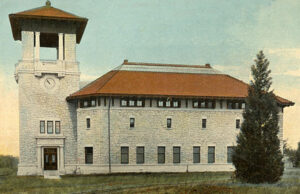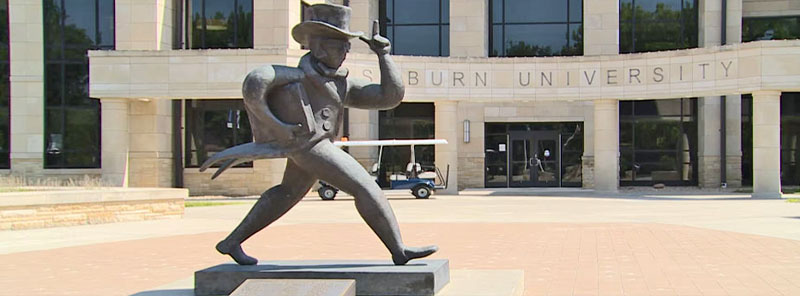Washburn University is a public university in Topeka, Kansas, that offers undergraduate and graduate programs and professional programs in law and business.
Washburn was founded as Lincoln College, a private Congregational school, on February 6, 1865. A group of church members had been trying to establish a college since 1857, but various obstacles and the Civil War hampered their efforts.
Washburn College’s founding story centers on Peter MacVicar, Harvey Dwight Rice, and Colonel John Ritchie. Many other men gave their time, labor, and money to Washburn, but these three men significantly directed and led the work.
During the summer and fall of 1865, a two-story building took shape on lots donated by John Ritchie on the corner of 10th and Jackson Streets in downtown Topeka. The front door faced west and had a good view of the state capitol under construction.
Since few young people had a high school education then, the founders decided to offer a three-year high school curriculum in addition to the college curriculum. Classes were opened to young women and men on January 3, 1866, with 38 high school students enrolled, including one African-American student. The stage was set, and the first two college students enrolled in Lincoln College in the fall of 1866.
The economy immediately following the Civil War made raising money difficult, and the fledgling college struggled to keep its doors open. The Board appointed Reverend Horatio Q. Butterfield, a professor, to be its fundraiser, soliciting money to help with expenses and create an endowment to put the college on a more secure financial footing.
The school was renamed “Washburn College” in 1868 after Ichabod Washburn pledged $25,000. Washburn was a church deacon, abolitionist, and industrialist who lived in Worcester, Massachusetts.
The following year, the Reverend H. Q. Butterfield was elected president and was succeeded in 1871 by the Reverend Peter MacVicar. Doctor MacVicar immediately set about erecting a campus building, and by 1872, $31,500 had been raised for its construction. The Academy building and site were sold to the city for $15,000, and by December 1872, the new building was enclosed. By 1874, Science Hall was ready for occupancy. The few young ladies who boarded at the school had rooms in the basement. The boys had rooms in the second story, and the faculty members occupied the floor between. On the first floor were also recitation rooms, the library, and a chapel at the west end. These were discouraging years for the president and trustees. In June 1877, the vested funds of the college were reported to be a little over $45,000. But in the spring of 1878, the situation became more encouraging.
In 1877, only 13 students were attending Washburn College; in 1878, there were 20. In 1879, Professor Stearns raised $3,000 in the City of Hartford, and Hartford Cottage was built as a dormitory for the girls. Before this time, the girls who were not rooming in Science Hall made the trip to and from town in a horse-drawn cab.
In 1884, the street railway was extended to the college, and a “horse car” drawn by mules made nine daily trips there. A few years later, an electric line was established.
By January 1883, Whitin Hall was ready as a cottage for the boys. In 1886, Holbrook Hall was occupied. In this same year, the Boswell Memorial was completed. Before this time, the college books were kept in the Science Hall. They were not arranged in order, and there was no catalog. When the books were moved to Boswell, which served as the library for 19 years, they were classified and cataloged by Professor Whittemore, Washburn’s librarian for 12 years.
The years following 1887 were years of rapid growth and change for the college. In 1889, the contract for the chapel was signed. In 1890, it was occupied and dedicated on baccalaureate Sunday. During this time, many hundred trees were planted on the campus. By this time, the endowment fund had increased to over $100,000. The remainder of Doctor Peter MacVicar’s administration was a trying period for both president and trustees and in 1895, he was compelled to give up his active work.
George M. Herrick was Washburn’s third president. During his presidency, a sizeable yearly deficit in the college funds was stopped, instruction facilities were greatly improved, and the number of students increased. The endowment fund also increased, and there was a noticeable growth in college spirit. At President Herrick’s resignation, the Reverend Norman Plass of Williamstown, Massachusetts, became the college president. To Doctor Plass, Washburn is indebted to the observatory building, the president’s residence, the heating plant, the Carnegie Library, the engineering shop, the law school, and the dispensary.
Washburn’s motto, “non nobis solum,” speaks directly to the university’s founding principles. It means “not for ourselves alone.” Charlotte Leavitt, an English professor, suggested the motto in the early 1900s.
On May 13, 1902, the Executive Committee honored themselves and the college by passing a resolution re-naming it after Doctor Peter MacVicar and “Old Science” after Harvey Rice. These workers who had given so much of themselves to Washburn most gratefully received this tribute.
The spring of 1903 was a most depressing time, for the memorable flood was at its height near commencement. The schools were closed, and many Washburn boys were at the front of the rescue work.
Dr. Frank Knight Sanders, formerly dean of Yale University School, assumed the presidency upon Doctor Plass’s resignation in 1908 and held the position for about six years. He resigned in the spring of 1914.
For two years, it had been known that when a sum of $75,000 for endowment had been raised, the college was to receive $35,000 more for a gymnasium. In 1908, that condition was more than fulfilled. The gift donor was unknown for some time, and the students described him as the “gym man.” At last, against his intentions, it became known that the “gym man” was Mr. Jonathan Thomas of Topeka. The building is a memorial to his son, Charles B. Thomas, a student at Washburn at one time. The gymnasium was dedicated in 1909.
In 1915, Doctor Sanders was succeeded by Dr. D L. McEachron, who was made the acting president. In 1916, Doctor McEachron was succeeded by Dr. Parley Paul Womer, who was elected president.
Congregational Church support diminished substantially throughout the 1920s. During the Great Depression of the 1930s, enrollment dropped, and the college struggled again to meet expenses and was forced to use the endowment funds. In 1940, President Philip King and the Board of Trustees decided this could not continue and voted to close the college unless a better solution could be found. The city of Topeka proposed to make it a municipal university, and in April 1941, the citizens voted overwhelmingly in favor of supporting the college with property taxes. On July 1, 1941, Washburn College became Washburn Municipal University of Topeka, governed by a Board of Regents. The long name was cumbersome, so “Municipal” was removed in 1952 and shortened to Washburn University.
With the infusion of new funding, Washburn reduced tuition, and enrollment began to increase. At the end of 1941, the U.S. entered World War II, and the Washburn campus was transformed into a Navy officer’s training facility in a few years. Young men came from around the country to get specialized training and take college courses. When the war ended, returning veterans were eager to get a college education under the GI Bill paid for by the government. Enrollment soared at Washburn, and the university built housing for married veterans and their families. Increased enrollment also meant more classroom space, followed by more than a decade of building.
On June 8, 1966, a half-mile-wide F-5 tornado cut a diagonal path of destruction across the Washburn campus and Topeka. When the winds stopped, the campus was in shambles, and five buildings were damaged beyond repair. President John Henderson and the Board did not even consider closing the school. The summer school was held in rented space at Topeka West High School and area churches. Rubble was cleared throughout the summer, windows and roofs were replaced, and buildings were cleaned. Many mobile classrooms were installed on campus, courtesy of the Federal Government, and the university held classes on campus in the fall semester of 1966. Destroyed buildings included Rice Hall, Boswell Hall, MacVicar Chapel, Crane Observatory, and the Thomas Gymnasium.
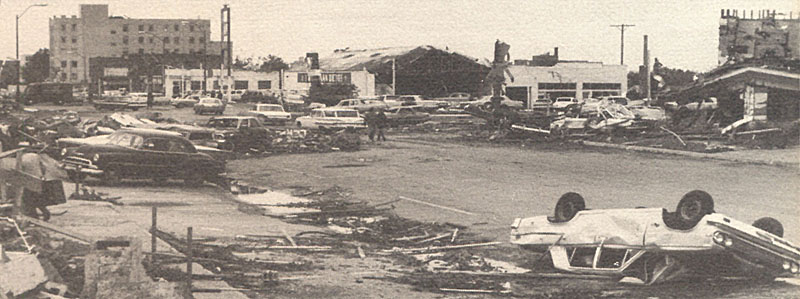
Topeka, Kansas Tornado June 1966.
All the classrooms were replaced in the next five years, and the university switched from rebuilding to growing again. The School of Nursing started as a small department in 1974 and quickly grew to become a school. Numerous certificate and two-year programs were added during this period. The business and economics departments were organized into the School of Business and grew swiftly. During the last half of the 20th century, Washburn had transformed into a thriving, more career-oriented university while still preserving its liberal arts heritage.
In 1999, the university’s primary funding was moved from city property tax to a percentage of Shawnee County sales tax revenue. This change created a broader funding base, allowing tuition to rise more slowly. President Farley’s vision after he was hired in 1997 was to attract more traditional-age students and create a residential culture on campus. With increased revenue and fundraising, the university built more residence halls, renovated the football field, and created student-friendly facilities.
Today, six schools are on Washburn’s beautiful 160-acre campus, including the College of Arts and Sciences, the School of Applied Studies, the Business School, the School of Nursing, the School of Law, and the Washburn Institute of Technology. Washburn has 550 faculty members who teach more than 6,100 undergraduate and nearly 800 graduate students. The university’s assets include a $158 million endowment.
©Kathy Alexander/Legends of Kansas, updated August 2024.
Also See:
One-Room, Country, & Historic Schools of Kansas
Past Colleges & Universities of Kansas
Sources:
Blackmar, Frank W.; Kansas: A Cyclopedia of State History, Vol I; Standard Publishing Company, Chicago, IL 1912.
Washburn University
Wikipedia


